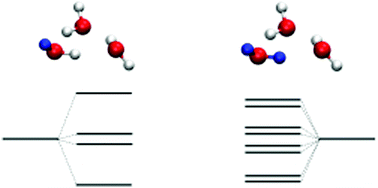Tunnelling splitting patterns in some partially deuterated water trimers†
Abstract
We apply our recently developed semiclassical method for calculating tunnelling splittings (TS) in asymmetric systems to make the first characterization of the ground-state TS pattern of some partially deuterated water trimers. Similarly to homoisotopic water trimers, the ground-state TS patterns are explained in terms of six distinct rearrangement mechanisms. TS patterns in (D2O)(H2O)2 and (H2O)(D2O)2 are composed of sextets induced by the dynamics of flips, and each of its levels is further finely split into a quartet of doublets and a doublet of quartets, respectively, due to various bifurcation dynamics. The TS pattern is obtained using 18 distinct tunnelling matrix elements. TS patterns of (HOD)(H2O)2 and (HOD)(D2O)2 each consists of two sextets, belonging to in-bond and out-of-bond substituted isomers. These sextet levels are further split into quartets by bifurcations. The TS pattern is computed in terms of 13 matrix elements. We also derive analytic expressions for bifurcation tunnelling splittings in terms of tunnelling matrix elements using symmetry. The present approach can be applied to other water clusters and also to the low-lying vibrationally excited states and should help in the interpretation and assignment of experimental spectra in the future.



 Please wait while we load your content...
Please wait while we load your content...